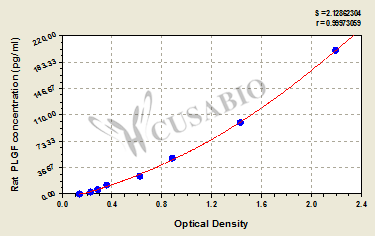The Rat placenta growth factor(PLGF)ELISA Kit allows for the in vitro quantitative determination of PLGF concentrations in serum, plasma, or tissue homogenates. The detection mechanism of this kit is based on the Sandwich-ELISA technique. PLGFin the sample is bound to the anti-rat PLGFantibody immobilized on the microtiter plate and then sandwiched with a Biotin-labeled PLGFantibody. The solution color develops into blue after the ordinal addition of HRP-avidin and TMB. The color development is terminated after adding the stop solution, and the color turns from blue to yellow. The color intensity is positively correlated with PLGFcontent in the sample. This kit exclusively recognizes rat PLGF. The kit has been quality controlled with high sensitivity, strong specificity, good linearity, precision of less than 10%, recovery of 89%-98%, and high lot-to-lot consistency. Refer to the product manual for more information.
PLGF is a member of the VEGF family and is mainly expressed in the placenta. It is a crucial molecule in angiogenesis and vasculogenesis, in particular during embryogenesis. Specifically, PLGF plays a role in trophoblast growth and differentiation. In human atherosclerotic lesions, PLGF expression is linked to plaque inflammation and neovascular growth. PLGF is also a potential biomarker for pre-eclampsia, a pregnancy complication characterized by hypertension and proteinuria in pregnancy.






